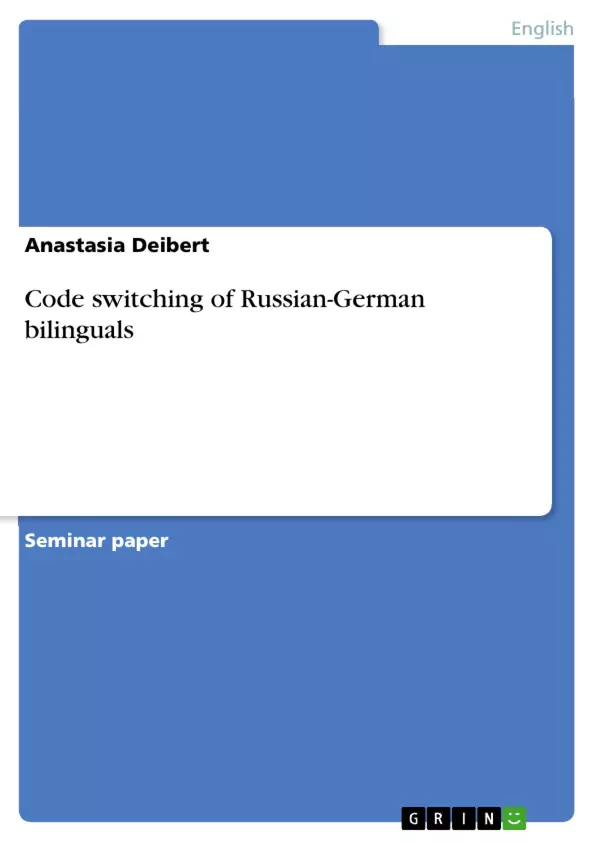In the following pages I want to focus on the code switching of Russian-German bilinguals. The phenomenon of code switching has its origin in the research of bilingualism and code switching can be examined from different perspectives. There are grammatical or syntactic, sociolinguistic or pragmatic, conversational and psycholinguistic aspects of code switching. In which situations is code switching possible or probable? Where does code switching seem to be possible syntactically? Why do speakers code-switch? Do bilingual speakers behave in another way in different social situations?
Firstly, I will give some definitions of the term “code switching” and I will define the various types of code switching. In addition, I will concentrate on Shana Poplack’s grammatical constraints and on Carol Myers-Scotton’s Matrix and Embedded Language theory. The next chapter will deal with my case study. First of all, I will name some relevant characteristics of Russian and then the procedure of the case study will be presented. Afterwards, while analysing my collected data I will try to find similarities as well as differences with regard to Poplack’s and Myers-Scotton’s theories and I will take a look at the functions of code switching. The conclusion will comprise the main points and some suggestions for further discussion.
Up to now many researches on code switching were undertaken. As a consequence, various definitions and types of code switching can be found throughout the history of research on code switching. In this chapter I will concentrate on two of the major theories of code switching – on Poplack’s and Myers-Scotton’s code switching theories. Code switching is the term for different languages coming into contact with one another in a conversation. This could be a general definition for code switching. Bilingual or multilingual speakers, people who possess two or even more languages, normally tend to code-switch, that means that they change from one language to the other and use words and phrases from distinct languages.
According to Wei (2000, 16) code switching occurs “when a bilingual talks to another bilingual with the same linguistic background and changes from one language to another in the course of conversation”. Poplack (2000, 224) defines code switching as “the alternation of two languages within a single discourse, sentence or constituent”.
Inhaltsverzeichnis (Table of Contents)
- Introduction
- Theories of Code Switching
- Definition and Types of Code Switching
- Poplack’s Two-Constraint Model
- The Free Morpheme Constraint
- The Equivalence Constraint
- Myers-Scotton’s Matrix Language Frame (MLF) model
- My Case Study
- Relevant Characteristics of Russian
- Method of Investigation
- Procedure
- Participants
- Analysis of the Data
- Inter-sentential Code Switching
- Intra-sentential Code Switching
- Tag Switching
- Conclusion
Zielsetzung und Themenschwerpunkte (Objectives and Key Themes)
This seminar paper focuses on code switching among Russian-German bilinguals living in Germany, investigating the linguistic phenomenon from both grammatical and sociolinguistic perspectives. It aims to analyze the different types of code switching and identify the functions behind them. The paper also examines the applicability of existing theories like Poplack’s two-constraint model and Myers-Scotton’s Matrix Language Frame model to the specific case of Russian-German code switching.
- The linguistic phenomenon of code switching
- Different types of code switching (inter-sentential, intra-sentential, and tag switching)
- The functions and motivations behind code switching
- The application of major code switching theories (Poplack’s model and Myers-Scotton’s model)
- The specific case of Russian-German code switching and its unique characteristics.
Zusammenfassung der Kapitel (Chapter Summaries)
The introduction provides a general overview of code switching, highlighting its different aspects and research interests. Chapter 2 delves into existing theories of code switching, focusing on Shana Poplack’s two-constraint model and Carol Myers-Scotton’s Matrix Language Frame model. The case study in Chapter 3 introduces the family of Russian-German bilinguals as the subject of the investigation, describing their linguistic background and the methodology used in the data collection. Chapter 4 presents the analysis of the collected data, examining examples of inter-sentential, intra-sentential, and tag switching, while comparing and contrasting the observed patterns with the established code switching theories. The conclusion summarizes the main findings and discusses further research directions.
Schlüsselwörter (Keywords)
The core concepts of the paper revolve around the multifaceted phenomenon of code switching, particularly in the context of Russian-German bilingualism. Key terms include: code switching, inter-sentential code switching, intra-sentential code switching, tag switching, Poplack’s two-constraint model, the Free Morpheme Constraint, the Equivalence Constraint, Myers-Scotton’s Matrix Language Frame (MLF) model, Matrix Language, Embedded Language, bilingualism, linguistic competence, and language contact.
- Quote paper
- Anastasia Deibert (Author), 2007, Code switching of Russian-German bilinguals, Munich, GRIN Verlag, https://www.grin.com/document/88700



